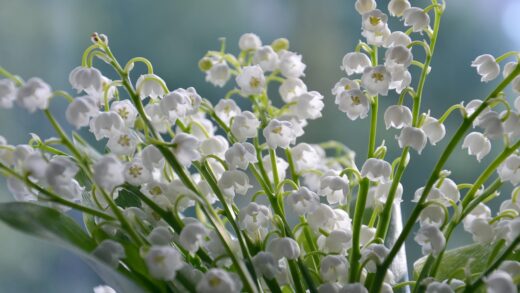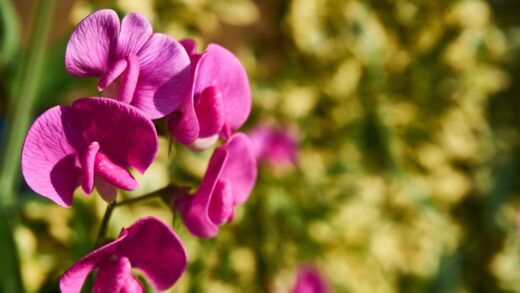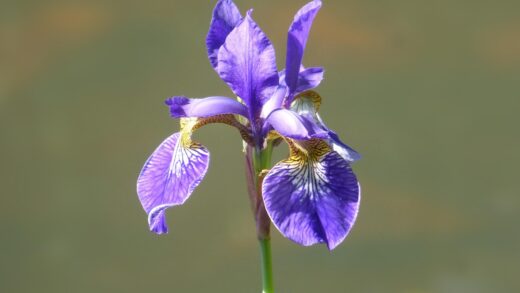Understanding the nuanced water requirements of purpletop vervain is central to its cultivation, as this is a plant that decidedly prefers to be on the drier side once it is mature. Its ability to tolerate periods of drought is one of its most valued characteristics, making it an excellent candidate for water-wise and low-maintenance garden designs. However, this drought tolerance is not immediate and must be cultivated through proper watering practices during the plant’s establishment phase. The key to successful irrigation lies in finding the delicate balance between providing enough moisture for healthy growth and avoiding the waterlogged conditions that can be fatal to the species. Mastering this balance ensures a resilient plant that will reward you with a profusion of its signature purple blooms throughout the season.
The natural habitat of purpletop vervain, the sun-drenched grasslands and open woodlands of South America, provides critical clues about its relationship with water. In these environments, the plant is accustomed to periods of infrequent but deep rainfall, followed by extended dry spells. This has conditioned it to develop a deep and efficient root system capable of seeking out moisture far below the soil surface. Therefore, our irrigation practices should aim to mimic this natural cycle of deep soaking and subsequent drying, rather than providing constant, shallow moisture which can lead to a weak and dependent root structure.
The life stage of the plant is the primary determinant of its watering needs, with a clear distinction between newly planted specimens and those that are fully established. A young plant, with its limited root system, is far more vulnerable to drying out and requires consistent attention to moisture levels in its first few weeks and months in the garden. In contrast, a mature plant that has been in the ground for a year or more becomes remarkably self-sufficient, often thriving with minimal supplemental irrigation. Recognizing and adapting to this transition is a fundamental skill for the successful gardener.
Furthermore, external factors such as climate, soil type, and whether the plant is grown in the ground or in a container will significantly influence its water requirements. A vervain growing in a sandy soil in a hot, dry climate will naturally require more frequent watering than one in a temperate region with heavier soil. Similarly, container-grown plants have a much more limited reservoir of soil and moisture, demanding a more vigilant approach to irrigation. A keen sense of observation, paying attention to both the plant and its environment, is the most valuable tool in providing the right amount of water at the right time.
Understanding verbena’s natural water needs
To truly grasp the watering needs of purpletop vervain, it is essential to look to its origins, as the plant’s physiology has been shaped by its native environment. Hailing from regions in South America characterized by well-drained soils and fluctuating rainfall, it has evolved to be highly resilient and opportunistic. It is not a plant of marshes or riverbanks; rather, it thrives in conditions where the soil is allowed to dry out between periods of rain. This evolutionary background has endowed it with a deep taproot and a fibrous root system designed to efficiently capture available moisture and withstand dry conditions.
More articles on this topic
This inherent adaptation means that purpletop vervain has a fundamental intolerance for consistently wet soil. When the soil remains saturated for extended periods, the air pockets within it become filled with water, depriving the roots of the oxygen they need to function and respire. This lack of oxygen leads to a condition known as root rot, where the roots begin to decay, lose their ability to absorb water and nutrients, and ultimately cause the entire plant to fail. Consequently, providing excellent drainage is the single most important factor in meeting the plant’s water needs, as it prevents the soggy conditions the plant cannot endure.
The plant’s physical structure also offers clues to its water-wise nature. The stems are wiry and the leaves are relatively small and textured, which helps to minimize water loss through transpiration, especially when compared to plants with large, lush leaves. During periods of drought, an established plant may show signs of slight wilting during the hottest part of the day, but it will typically recover quickly as temperatures cool in the evening. This is a natural coping mechanism and not necessarily a sign that it needs immediate watering. Learning to read these signals is key to avoiding unnecessary irrigation.
Therefore, the goal of the gardener should not be to keep the soil constantly moist, but to provide water in a way that supports the development of a deep, self-sufficient root system. This involves allowing the soil to dry out to a certain extent between waterings, which encourages the roots to grow deeper in search of more stable moisture reserves. This approach fosters the very drought tolerance that makes purpletop vervain such a desirable garden plant, creating a specimen that is both beautiful and resilient in the face of variable weather conditions.
Establishing an effective watering schedule
For a newly planted purpletop vervain, establishing an initial watering schedule is crucial for its survival and long-term health. During the first few weeks after planting in the spring, you should aim to keep the soil consistently moist but never waterlogged. This typically translates to watering deeply once or twice a week, depending on your climate and rainfall. The best way to determine when to water is not by a rigid schedule, but by checking the soil itself. Insert your finger about five centimetres into the soil near the base of the plant; if it feels dry at that depth, it is time to water.
More articles on this topic
The method of watering is just as important as the frequency. It is far more beneficial to provide a deep, thorough soaking that allows water to penetrate 15 to 20 centimetres into the soil profile than to give light, daily sprinklings. Deep watering encourages the roots to grow downwards, creating a strong anchor and tapping into deeper, more reliable sources of moisture. Shallow watering, in contrast, promotes the development of a shallow root system that is highly vulnerable to drying out during hot or windy weather. Use a soaker hose or a watering can directed at the base of the plant to ensure the water goes directly to the root zone and to keep the foliage dry, which helps prevent fungal diseases.
As the plant becomes established over its first growing season, you can gradually begin to reduce the frequency of supplemental watering. As its root system expands and deepens, it will become increasingly efficient at finding its own water. By mid-summer, a plant that was put in the ground in spring may only need watering once every week or two, and only then if there has been no significant rainfall. This gradual tapering of irrigation is essential for transitioning the plant from a state of dependence to one of self-sufficiency and robust drought tolerance.
Once the purpletop vervain has successfully completed its first full year in the garden, its need for supplemental irrigation will be minimal in most temperate climates. A mature, established plant can often withstand several weeks of dry weather without any intervention. Your role then shifts from regular watering to monitoring the plant during extreme or prolonged periods of drought. If you notice the leaves are wilting and do not recover in the cooler evening hours, this is a clear sign that the plant is under stress and would benefit from a deep, restorative soaking.
Irrigation techniques for optimal health
The choice of irrigation technique can have a significant impact on the health and well-being of your purpletop vervain. The most highly recommended method is drip irrigation or the use of soaker hoses, as these systems deliver water slowly and directly to the soil at the base of the plant. This approach is highly efficient, minimizing water loss through evaporation and ensuring that the moisture reaches the root zone where it is needed most. Crucially, it also keeps the foliage and stems dry, which is a key strategy in preventing the development of fungal diseases like powdery mildew that thrive in damp conditions.
If you are watering by hand with a hose or watering can, it is important to adopt a similar targeted approach. Always aim the water at the soil around the base of the plant rather than spraying it over the top of the foliage. Watering from above can not only encourage disease but can also be wasteful, as much of the water may evaporate from the leaves before it ever reaches the soil. Take your time to allow the water to soak in slowly and deeply, moving around the base of the plant to ensure the entire root zone receives adequate moisture.
The timing of your watering is another critical factor for optimal plant health. The best time to water purpletop vervain, and indeed most garden plants, is early in the morning. Watering at this time allows the plant to absorb the moisture and prepare for the heat of the day. It also ensures that any moisture that does splash onto the leaves has plenty of time to dry in the sun, reducing the risk of fungal growth. Watering in the middle of a hot, sunny day is inefficient due to high evaporation rates, while evening watering can leave the foliage damp overnight, creating an inviting environment for diseases.
For purpletop vervain grown in containers, the irrigation technique needs to be slightly different due to the limited soil volume. Water the pot thoroughly until you see water begin to drain from the holes at the bottom. This ensures that the entire root ball has been moistened. Allow the top five centimetres of the compost to dry out completely before watering again. Container-grown plants will require much more frequent watering than their garden-grown counterparts, potentially daily during hot, sunny weather, as the soil in pots heats up and dries out very quickly.
Adjusting watering for different seasons and climates
The water requirements of purpletop vervain are not static; they fluctuate significantly with the changing seasons, and your irrigation practices must adapt accordingly. In the spring, as new growth emerges, the plant’s demand for water begins to increase. During this period, consistent moisture is important to support the development of strong stems and lush foliage. However, spring weather can be unpredictable, so it is essential to adjust your watering based on natural rainfall, avoiding irrigation during wet spells to prevent the soil from becoming overly saturated.
Summer is the season when the plant is in its peak growth and flowering phase, and it is also when temperatures are at their highest. While an established plant is drought-tolerant, it will perform best and produce more flowers if it receives occasional deep watering during extended dry periods. In particularly hot and arid climates, you may need to provide supplemental water once every week or two to prevent stress. Conversely, in climates with regular summer rainfall, you may not need to water at all. Close observation of the plant is your best guide during these months.
As autumn approaches, the plant begins to slow its growth and prepare for winter dormancy. This is a critical time to reduce the frequency of your watering. The combination of cooler temperatures and shorter days means the plant’s water uptake is significantly lower, and the soil will dry out much more slowly. Continuing to water at summer levels during the autumn is a common mistake that can lead to waterlogged soil and increase the risk of the crown rotting over the winter. In most regions, natural autumn rainfall will be more than sufficient.
During the winter, a dormant purpletop vervain requires no supplemental irrigation at all. The plant is not actively growing, and its metabolic processes have slowed to a minimum. The primary concern during this season is to protect the plant’s crown from excessive moisture and cold. Ensuring the soil is well-drained is paramount, as frozen, waterlogged soil can be fatal. This seasonal cycle of adjusting your watering practices—providing moisture during active growth and withholding it during dormancy—is fundamental to the long-term perennial success of purpletop vervain.
Signs of overwatering and underwatering
Recognizing the visual cues that purpletop vervain provides is an essential skill for managing its irrigation correctly. Overwatering is the more common and more dangerous of the two problems, and its signs can sometimes be misleading. A primary symptom of overwatering is the yellowing of the lower leaves, a condition known as chlorosis. This occurs because the waterlogged soil prevents the roots from absorbing essential nutrients. The plant’s stems may also become soft, weak, or mushy near the base, and in advanced cases of root rot, the entire plant may wilt and fail to recover even when the soil is wet.
Another clear indicator of excessive moisture is a lack of new growth or a general failure to thrive. If a plant seems stunted and is not putting on new leaves or stems during the growing season, it is worth investigating the soil conditions. A soil that is constantly damp to the touch is a red flag. You may also notice a sour or unpleasant smell coming from the soil, which is a sign of anaerobic conditions where the roots are decaying due to a lack of oxygen. If you suspect overwatering, you must withhold all supplemental irrigation immediately and allow the soil to dry out thoroughly.
The signs of underwatering, while less common in established plants, are generally more straightforward to diagnose. The most obvious symptom is wilting, where the leaves and upper stems droop, particularly during the hottest part of the day. The leaves may also feel dry or crispy to the touch and can develop brown, dried-out edges. In severe cases, the lower leaves may turn completely brown and drop off as the plant attempts to conserve moisture by shedding some of its foliage. The overall growth rate will be slow, and the plant will produce significantly fewer flowers.
Unlike the wilting caused by root rot, a plant that is wilting from a simple lack of water will typically show a rapid and dramatic recovery after a thorough watering. If you see signs of underwatering, provide a deep, slow soaking to the root zone, preferably in the early morning. It is important to then monitor the plant and the soil conditions to determine if a more regular watering schedule is needed, which is most likely to be the case for young plants or those grown in containers or very sandy soil. Learning to distinguish between the wilting of a thirsty plant and the wilting of a drowning one is a key aspect of successful cultivation.


















